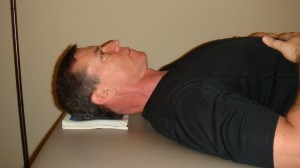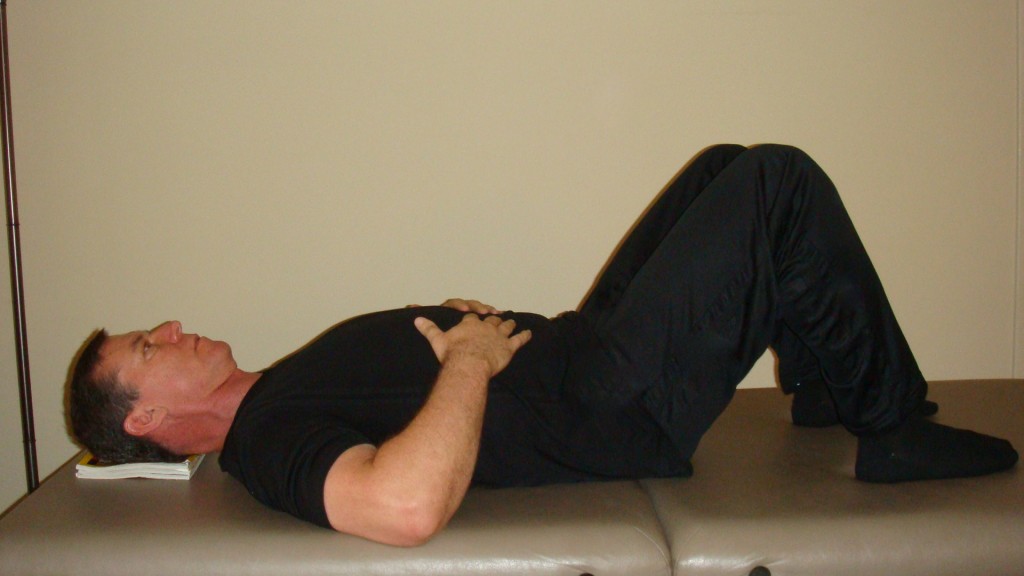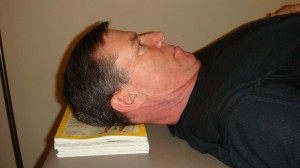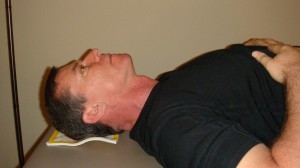Well timed and well directed rest is one of the most important elements for a serious musician to maintain and develop a healthy practice regimen. Unfortunately, many musicians neglect this crucial element, sometimes looking at rest as a necessary evil, something that steals precious time away from “real” practice.
But truth be told, it is rest in any activity that optimizes effort. All effort and no rest leads to fatigue, lack of inspiration, compromised technical habits, unclear thinking, and injury. I could write volumes on the when and how much of effective rest. Instead, I’ll introduce you to a highly effective way to practice resting that is taught and used regularly in the Alexander Technique. It’s called constructive rest (also referred to as active rest).
In this rest practice, you lie down in a semi-supine position (on your back with your knees bent and feet on the floor) on a firm surface (e.g., a carpeted floor) with something firm to support your head, such as books or magazines. Your arms are bent at the elbow with your hands resting on the side of your torso, somewhere between the bottom of your ribcage and your hips. You also leave your eyes open (remember it’s called active rest) so you can keep your senses in tune with your body. It looks like this:
Simply lying in this position for 15 to 20 minutes at a time can work wonders for you. Here are just a few of the benefits of constructive rest:
- It helps to restore the length of your spine by letting your back and neck muscles release into their natural resting length.
- It allows for your intervertebral discs (the soft cushions between your neck and back bones which absorb shock) to re-hydrate to their optimum thickness (this too lets your spine get back to its resting length).
- It allows your breathing to return to an easy, natural and well-functioning state.
- It calms your nervous system, clears and centers your mind and brings you back in touch with the present moment.
- It helps you to become better aware of your habits of tension (and helps you connect thought to gesture to reduce your tension) thereby giving you a better gauge of effort and tension when you play music.
- It puts you into a state of calm alertness, readying you to play music at your highest level.I’ve been practicing constructive rest for many years now, with ever increasing benefit.
For me it’s as essential as sleep, food and hydration to stay healthy and play my best. If you have chronic back and/or neck pain, this procedure can greatly reduce or even eliminate your symptoms. Here are the basic instructions for lying down in the semi-supine position for constructive rest:
Find a reasonably quiet place. If possible, allow yourself fifteen or twenty minutes to lie down.
Lie with your backside down on a flat, firm surface, e.g., a carpeted floor, or a wooden floor with a yoga mat or thin blanket beneath you. Do not lie down on a bed, cot, or sofa, as these surfaces are too soft and will not allow for the necessary feedback your body needs to release muscles.
You should also place something firm beneath your head for support, such as a few thin books or magazines. The height of this support will vary with each individual. If too high, the chin will be too close to the chest and will not allow enough space in the front of the neck; if too low, the head will tend to go “back and down” the spine, thus discouraging the natural lengthening process. Try different heights and find one that encourages the least amount of tension in the entire neck:
Too high
Too low

Good height
Once you are on your back, bend your knees to bring your feet flat onto the floor. Keep your heels in approximate line with your sitting bones. Your heels should be about twelve to fifteen inches from your buttocks.
Keeping your arms out and away from your torso (think of your arms as hands of a clock at 4 o’clock and 8 o’clock), bend your elbows to bring your palms to rest on the sides of your torso where your ribcage meets your abdomen. Make sure your hands are not touching one another, and that there is plenty of space between your ribcage and elbows:
Shoulders narrowing (arms too high)
Shoulders widening (better arm position)
Check your breathing by observing the flow of air in and out of your nostrils. Keep your eyes open during the entire session, from time to time noticing your environment. Scan yourself for any unnecessary tension or holding that you might be doing. Observe any changes within yourself that might take place. Rest and enjoy!
That’s all there is to it. By simply lying in this manner you activate great release and positive changes. If you like, you can also add the Alexander Technique primary directions. This is a simple set of mental directives to give yourself to encourage length and expansion in your body. They are as follows:
I allow my neck to be free, so that my head can release upward off the top of my spine.
I allow my entire torso to lengthen and widen.
I allow my knees to release forward from hip joints, and for one knee to release away from the other.
I allow my heels to release into the floor.
You simply think the directions, but don’t do anything about them. In fact your entire aim should be to do nothing at all. Non-doing we call it in the Alexander Technique. Just let yourself rest.
You can use this tool anytime you like. In my musical practice, I tend to use it as follows: I usually lie down for about 5 or 10 minutes before I practice to help bring me to the state of calm alertness I need to play well. When I take brief breaks during my practice (5 to 10 minutes) I’ll also lie down.
Or sometimes I’ll take a nice long break in my practice session and lie down for an entire 20 minutes. When I do this I feel completely restored (mind, body, spirit) and ready to resume. I often do this when I have an unusually long practice day.
Also, if I’m at a gig where space permits, I’ll lie down before I start and during the intermission (or sets). I’ve been told that in the U.K. (where the Alexander Technique is widely known and practiced by professional musicians) you can see 40 or more musicians lying down back stage during the intermission at orchestral performances.
So incorporate this highly effective tool into your practice routine. If you can’t manage 15 or 20 minutes, do it for 5 or 10. It will still help. Remember, rest is part of the process to improve, so don’t look at it as time wasted. Balance rest with effort and you’ll greatly increase your chances of staying healthy, injury free and energized as you practice and perform.





Wow, I’ve never heard of this technique, but I can really see it as being helpful – especially in terms of slowing down the mind and returning to the alert state which can be clouded during a practice session of striving and sometimes even being frustrated. This technique seems as though it would give you a “clean slate” to work with.
Once again, Bill, you’re providing some of the most valuable music education on the web. Thanks!
Doron, this way of resting is a treasure chest of benefits. It is integral to studying the Alexander Technique, and for me is essential for my growth, health and optimum musical practice efforts. You’re right in saying it clears the mind, but it doesn’t exactly slow it down. It’s more like it quiets the mind, putting you into a state of calm, effortless alertness (pretty good place to be to play music!) If you practice this everyday, you’ll be amazed by what you gain (besides avoiding injury and fatigue): greater self-awareness, the ability to integrate more things effortlessly in your attention, improved breathing…the list goes on. Thanks again for your kind words and for your input.
Ahh, OK, there’s a distinction between quieting and slowing down. For me, when my mind is moving quickly it’s usually not a good thing, but of course, in the case of music, as long as my mind is moving quickly for the purpose of making music, than a quick mind is obviously a good thing.
Thanks for clarifying!
Very often when you have what might be called a “racing” mind, in essence what you have is mind that is not connected to the present moment. Lot’s of thoughts anticipating the future and/or lots of thoughts rehashing the past. As you mentioned, to play music well, your mind must be quick (responsive, yielding and flexible), but that quickness is your ability to deal with the music moment by moment (again, staying connected to the present). So to get back to the benefits of lying in constructive rest, it helps quicken and resharpen your senses (good for playing music) as well as puts your mind in a receptive state (also good). Hope I’m not sounding too zen here, but (besides being a zen idea) it is in accordance with contemporary neurobiological research regarding consciousness and good performance. Effortless, calm alertness. Some folks call it being “in the zone.” Anyhow, thanks again for your input, Doron!
By all means, I love the zen/spiritual approach – thanks for clarifying!
I enjoyed the article, Bill, but particularly your exchange in the comments with Doron over the difference between quieting and slowing the mind. I think so often these two ideas are conflated, and your description of the difference between the two is clear and very helpful.
Your description of the racing mind being unable to stay in the present moment reminded me of Alexander’s retelling of the story of Carlyle. On hearing of the illness of is friend, he rushed home and grabbed a bottle of medicine that had helped his wife, without knowing what that medicine was for or what illness his friend actually had. Carlyle was acting “out of communication with his reason.” As a musician, when I allow my mind to race into the future or the past (or both at once!), I am not thinking about what I am doing, and what I have decided is best for my purpose in playing. I am effectively out of communication with my reason.
As you so clearly say in your article, one of the great benefits of Alexander’s work is that it enables one to STOP, to move outside of unclear thinking and once more become connected with our reasoning. And then we will play with greater attention to technique, with more spontaneity, and with a full and open-hearted experience of being in the present moment.
Thanks again!
Hi Jennifer, great to hear from you! I love the story of Carlyle. When I first read Alexander’s mention of it, it reminded me of a saying my father shared with me when I was a boy, “If the only tool you know how to use is a hammer, you see everything like it’s a nail.” It’s still amazing to me how people will jump to a “solution” to a problem without considering cause and effect (“choosing the right tool for the job”, my dad would say). Being put “out of communication with reason” is the root of all my difficulties, whether in playing music, or in interacting with my fellow beings (thankfully I have the Alexander Technique to help me address this issue!) And as you said, one of the great benefits of the Technique is that it enables one to STOP, in order to come back to clear thinking, and true, conscious choice. My first Alexander teacher, Frances Marsden, brought this lesson so gently, yet so powerfully to me during my lessons with her. It is pure gold. Hope all is well with you, and thanks for sharing your (always!) eloquently expressed thoughts.
Beautiful explanation of Alexander Technique’s constructive rest position!
Thanks, Mark! Constructive rest is a beautiful thing…
Hi,
Question about breathing during this position. Do I actively breath with deep inhalation and exhalation or do I just lie there and let gravity do its work? In my efforts doing this pose, breathing causes me tension in my stomach when I am actively trying to do it but I don’t know what I should do.
Hi Jason,
That’s a great question. I would suggest that you don’t try to actively breath while lying in the constructive rest position. Instead, let your breath “do itself”. The aim is not to breath deeply, but rather, to let yourself release muscles so that the breath is moving freely (breathing is well-coordinated). The best indicator of good breathing is free and supple movement of the rib cage. Lying in constructive rest encourages this freedom. So lie down, give yourself the directions to let your neck be free, and for your torso to lengthen and widen, and enjoy. Hope this helps. Thanks for asking!